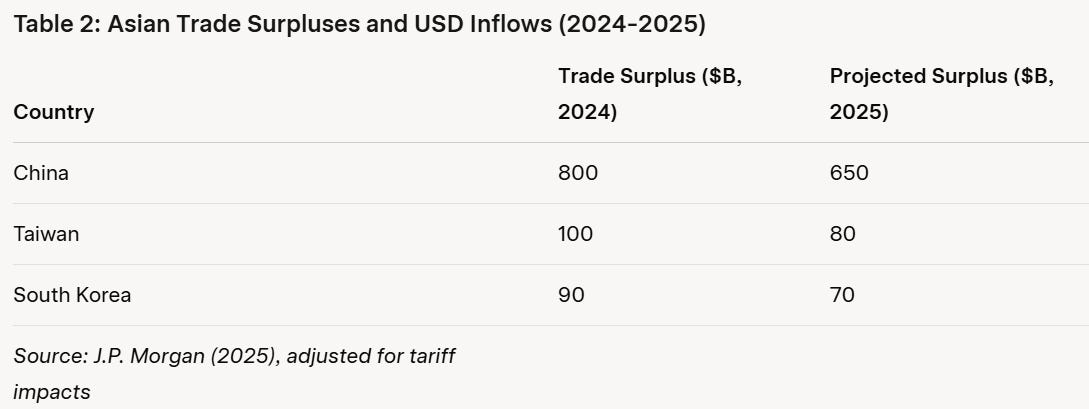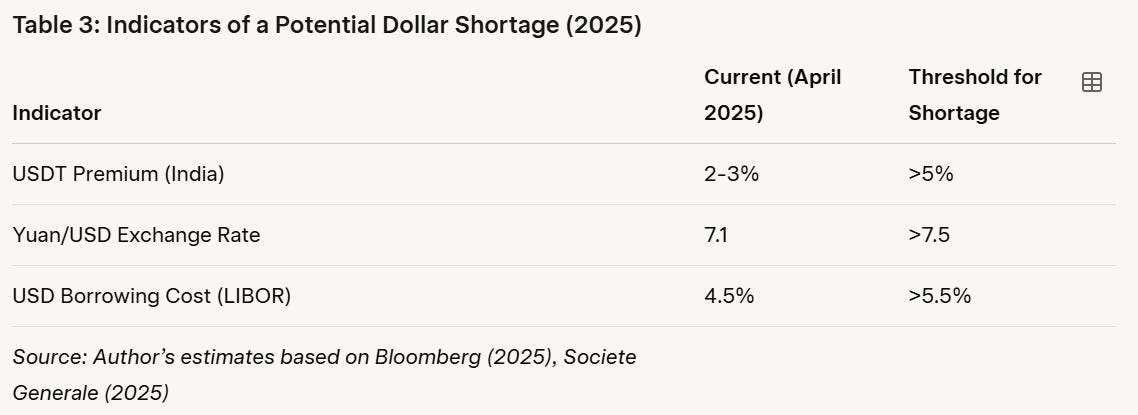
The Looming Dollar Shortage in Asia’s Spot Markets: Implications for Stablecoin Stability and Global Finance
Abstract
This article examines the potential for a U.S. dollar shortage in Asia’s spot markets in 2025, driven by trade disruptions, capital repatriation, and de-dollarization trends. The surge in Tether’s (USDT) market capitalization to $152 billion, fueled by Asia’s $1.5 trillion dollar surplus, underscores the region’s role in global finance and cryptocurrency markets. However, U.S. tariffs, regulatory pressures on stablecoins, and shifting capital flows could precipitate a liquidity crunch by Q3 2025, challenging USDT’s peg stability. Using empirical data and economic theory, this analysis explores the causes, timing, and implications of a dollar shortage, offering insights for policymakers and investors.
Introduction
The U.S. dollar’s role as the world’s reserve currency faces increasing scrutiny in Asia, where a $1.5 trillion dollar surplus has driven financial markets and the growth of stablecoins like Tether (USDT). In April 2025, USDT’s market capitalization reached $152 billion, reflecting Asia’s dominance in cryptocurrency trading (Reuters, 2025). However, warnings of a potential dollar shortage in Asia’s spot markets raise concerns about systemic risks, including the stability of USDT’s 1:1 peg to the dollar. This article investigates the drivers of a possible dollar shortage, its likely timeline, and its implications for global finance and stablecoin markets, supported by data and critical analysis.
Background: Dollar Liquidity and Stablecoins
Asia’s dollar surplus, estimated at $1.5 trillion, stems from export-led growth in countries like China, Taiwan, and South Korea. China held $959.8 billion in foreign currency deposits (mostly USD) by March 2025 (Bloomberg, 2025). This surplus has been channeled into dollar-denominated assets, including U.S. Treasuries and stablecoins, with USDT dominating 83% of centralized crypto exchange volumes (CoinMarketCap, 2025).
USDT, issued by Tether, serves as a liquidity bridge between fiat and digital assets, particularly in Asia, where capital controls drive stablecoin demand. Its $152 billion market cap, a 36% increase from 2024, correlates with Bitcoin rallies (X Post, 2025a). However, Tether’s reserves—$120 billion in U.S. Treasuries and $5.6 billion in excess assets—face scrutiny amid a U.S. federal investigation into sanctions violations (Wall Street Journal, 2025).

Causes of a Potential Dollar Shortage
Trade Disruptions from U.S. Tariffs
U.S. tariffs, announced in April 2025, target Asian exporters, reducing dollar inflows from trade surpluses (Reuters, 2025). China’s yuan is projected to weaken by 5-7% by Q3 2025, increasing USD demand for imports and debt servicing (Societe Generale, 2025). This could tighten dollar liquidity in spot markets, particularly for non-bank firms reliant on short-term USD financing.

Capital Repatriation and Hedging
Asian institutions, such as Taiwan’s life insurers with $2.5 trillion in dollar assets, are repatriating capital and hedging USD exposure, potentially selling $70 billion in dollars (Bloomberg, 2025). This trend, driven by tariff uncertainties, reduces spot market liquidity. For example, the Taiwan dollar surged 10% in April 2025 as exporters converted USD earnings (X Post, 2025b).
De-Dollarization Trends
Efforts by China and India to trade in local currencies, motivated by U.S. sanctions risks, reduce dollar demand for trade but increase it for debt repayment (Bank for International Settlements, 2024). The unwinding of $80 trillion in global FX swaps could strain dollar liquidity if non-bank firms seek USD to settle obligations.
Monetary Policy Divergence
The Federal Reserve’s rate cuts, started in September 2024, may pause in 2025 due to tariff-driven inflation (2.5% in the U.S.) (J.P. Morgan, 2025). Higher U.S. rates could attract capital outflows from Asia, tightening dollar supply. Asian central banks may sell USD reserves to stabilize currencies, exacerbating shortages.
Timing of the Dollar Shortage
A dollar shortage is plausible by Q2-Q3 2025 (June-September), based on the following triggers:
-
Tariff Impacts: Full tariff implementation by mid-2025 will reduce Asia’s trade surpluses, tightening dollar inflows.
-
Capital Flows: Accelerated repatriation by Asian investors could intensify by Q2, reducing USD liquidity.
-
USDT Stress: A surge in USDT redemptions, driven by dollar scarcity, could destabilize its peg by Q3, especially if Tether faces regulatory restrictions.

Asia’s $1.5 trillion dollar surplus and Tether’s $5.6 billion excess reserves provide buffers, but external shocks (e.g., sanctions, banking restrictions) could accelerate a shortage. A 60-70% probability is estimated for Q3 2025, contingent on policy developments.
Implications for Stablecoin Stability and Global Finance
A dollar shortage could increase USDT premiums in Asia, as seen in India in January 2025, but redemption pressures risk de-pegging, as occurred in 2022 when USDT fell to $0.995 (CoinDesk, 2022). Tether’s reliance on U.S. Treasuries and ongoing U.S. investigations heighten risks (Wall Street Journal, 2025).
Globally, a dollar shortage could disrupt trade financing and weaken Asian currencies, impacting emerging markets with $1.2 trillion in USD-denominated debt due in 2025 (International Monetary Fund, 2025). The dollar’s safe-haven status and U.S. growth (2.7% in 2024) may mitigate severity, but de-dollarization challenges its dominance.
Policy and Investment Considerations
Policymakers should enhance stablecoin oversight, ensuring reserve transparency to prevent systemic risks. Asian central banks may need to manage USD reserves strategically. Investors should monitor USDT premiums, Asian currency movements, and U.S. policy developments, diversifying into gold or alternative stablecoins like USDC.
Conclusion
A dollar shortage in Asia’s spot markets by Q3 2025, driven by tariffs, repatriation, and de-dollarization, poses risks to USDT’s stability and global finance. While buffers exist, structural shifts necessitate vigilance. Future research should explore stablecoin dynamics and liquidity risks in emerging markets.
References
-
Bank for International Settlements. (2024). Global FX Swap Markets: Risks and Vulnerabilities. BIS Quarterly Review.
-
Bloomberg. (2025). China’s Foreign Currency Deposits Hit $959.8 Billion. March 2025 Report.
-
CoinDesk. (2022). Tether’s De-Pegging Event: Lessons from 2022. November 2022.
-
CoinMarketCap. (2025). Stablecoin Market Overview. April 2025.
-
International Monetary Fund. (2025). Global Financial Stability Report. April 2025.
-
J.P. Morgan. (2025). Global Economic Outlook: Tariff Impacts. April 2025.
-
Reuters. (2025). Trump Tariffs Shake Dollar Markets. April 4, 2025.
-
Societe Generale. (2025). Emerging Market Currency Forecast. January 2025.
-
Wall Street Journal. (2025). Tether Faces Federal Investigation. March 2025.
This post is originally published on ROADTOMILLION.

